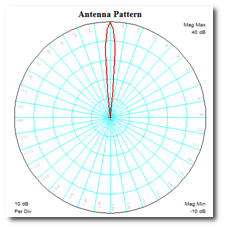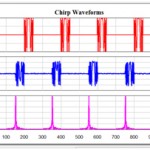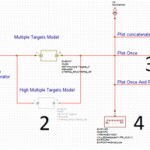Introduction
A synthetic aperture radar (SAR), is a type of radar used to create two- and three-dimensional representations of an object. SAR uses the motion of the radar antenna over a targeted region to provide finer spatial resolution than is possible with conventional beam-scanning radars. The signal processing uses magnitude and phase of the received signals over successive pulses from elements of a synthetic aperture. The SAR is similar to a phased array radar, but contrary to the large number of parallel antenna elements used in a phased array, SAR uses one antenna in time-multiplex.
Students at the Technion – Israel Institute of Technology SAMPL Lab built an efficient, easy-to-use SAR simulator that could be connected to MATLAB for signal processing, thereby significantly speeding up design time. The SAMPL Lab design focused on sub-Nyquist sampling of the received signal and full reconstruction of the image.
The Design Project

Figure 1. Amplitude presentation of multiple targets with additive white Gaussian Noise.
The students, supervised by Kfir Aberman and Prof. Yonina Eldar, created an SAR simulator (Figure 1) that could handle many targets on the surface and perform very quickly. They then used MATLAB to calculate the object shapes.
The students used high-frequency design software, as shown in Figures 2, 3, and 4, for this SAR simulator research project. The software gave the students a simple yet accurate look at the architecture and design phases of the SAR simulator.
Figure 4. Top view of the hierarchical design in VSS, including chirp generator, target models, control blocks, and MATLAB blocks for co-simulation and signal processing.

Figure 2. The antenna radiation pattern shown in AXIEM EM simulator.
It was necessary to include several key capabilities within the SAR simulator to ensure the project’s success. It had to contain a signal generator, an RF transmitter, an antenna, an RF receiver moving target detector (MTD), and links to third-party tools such as MATLAB (Figure 5) and LabVIEW.
Figure 5. Visualization of the data in MATLAB.
NI AWR Design Environment provided a solution for including these specifications without being too complex for the students to use successfully. By using the graphical architecture of the software, they were able to build independent blocks that were suitable for specific tasks. In addition, the software provides many built-in blocks that the students were able to use in this project.
A small influence on latency was noticed when simulating a large number of targets. This was an important discovery because within this project there was a need to perform calculations on many targets in order to build a picture of the object shapes.
- Figure 3. Transmitted signal waveform chirp with a set pulse repetition Interval shown in red. Signals returning back from the targets are shown in blue. The pink waveform shows the returning signals after the match filtering process
- Figure 4. Top view of the hierarchical design in VSS, including chirp generator, target models, control blocks, and MATLAB blocks for co-simulation and signal processing.
- Figure 5. Visualization of the data in MATLAB.
Conclusion
Students at the Technion – Israel Institute of Technology SAMPL Lab built an efficient, easy-to-use SAR simulator that could be connected to MATLAB for signal processing, thereby significantly speeding up design time. The simulator could handle many targets on the surface and perform very quickly. Because the SAR had to contain several RF parts such as a signal generator, an RF transmitter, an antenna, an RF receiver moving target detector (MTD), the students used high-frequency design software, which enabled them to successfully complete their design project.










